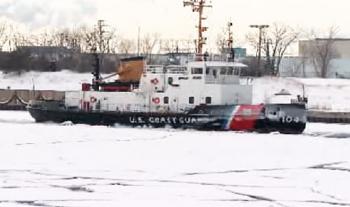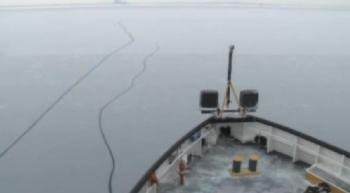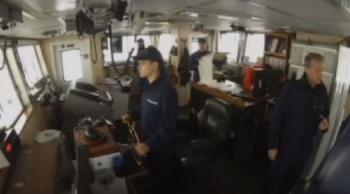 Today's big thaw hasn't done anything to reduce the ice coverage on the Great Lakes. Last year, 38 percent of the Great Lakes were ice-covered. Today, ice covers 85 percent of the lakes, the largest amount of ice coverage in 35 years. All that ice bedevils shipping, but shippers will be very happy in the spring if water levels rise as much as scientists are predicting.
Today's big thaw hasn't done anything to reduce the ice coverage on the Great Lakes. Last year, 38 percent of the Great Lakes were ice-covered. Today, ice covers 85 percent of the lakes, the largest amount of ice coverage in 35 years. All that ice bedevils shipping, but shippers will be very happy in the spring if water levels rise as much as scientists are predicting.
The sun is just beginning to rise over Chicago's ice-clogged harbor. Docked at Navy Pier, the Coast Guard's ice cutter, the Biscayne Bay, starts gearing up for a long day. Breaking a track through the harbor ice, the Biscayne Bay heads out to clear shipping lanes on Lake Michigan. The ship is based in northern Michigan near the Straits of Mackinac. It’s rare that the ice breakers are needed in the southern half of the lake.
“This is actually our first time in the winter down to the south end of Lake Michigan, so I can't say what it's been like down here. But in the straits, it's been the worst winter in 25 years,” said Lt. j.g. Paul Junghans.
The hull of the 140-foot long ice breaker is reinforced with extra steel around the water line and bow. Powerful bubblers on the bow and stern shoot out air that helps lubricate the hull against the ice. Rather than cutting the ice, the ship acts like a small tank and just plows right through it.
“We call that plate ice. It’s about 8 to 10 inches thick right now. It’s not too bad. And then, you can see some of the plate has broken up right there. Once that starts piling up on itself, it creates a windrow, and that makes it difficult for us to get through the ice,” said 1st Lt. Mike Singleton.
 About an hour out of Chicago, the Biscayne Bay hit a windrow. As the heavy ice slowed the boat, orders were given for more aggressive ice-breaking maneuvers.
About an hour out of Chicago, the Biscayne Bay hit a windrow. As the heavy ice slowed the boat, orders were given for more aggressive ice-breaking maneuvers.
“This is where we back and ram. We’ll put the boat in a surge propulsion, we'll back up about three ship lengths, and then we’ll go as fast as we can,” said Singleton. “And we’ll hit this windrow, and we’ll come up over the ice and continue on.”
The Great Lakes haven't seen this much ice since 1979. The Great Lakes Environmental Research Laboratory (GLERL) reports that 81 percent of all the Great Lakes are now covered with ice. Lakes Superior, Huron and Erie lead the way with 95 percent coverage. Lake Michigan is next with 81 percent coverage and Lake Ontario with 40 percent. The extensive ice coverage surprises even longtime observers of the lake, like Joel Brammeier, President and CEO of Alliance for the Great Lakes.
“The idea of the Great Lakes freezing over entirely is simply something that doesn’t happen,” he said. “In fact, even on Lake Superior, the last time Lake Superior froze over was in the mid-90s. So this is a very special, unusual winter.”
 The heavy ice cover has nearly called a halt to Great Lakes shipping. Though shipping does slow down during the winter months, boats are still active, particularly in the southern end of the lake. But this year, the Coast Guard has been needed to keep the southern shipping lanes open.
The heavy ice cover has nearly called a halt to Great Lakes shipping. Though shipping does slow down during the winter months, boats are still active, particularly in the southern end of the lake. But this year, the Coast Guard has been needed to keep the southern shipping lanes open.
“The Lake Carriers’ Association which represents a bunch of the companies here has these established tracks in the lake. That's what all the lakers take,” said Junghans. “So, in general, not always, we try to follow those, especially in the winter in the ice because that's where they want to go, so we’re going to break a track where they want to go.”
On this day, the Biscayne Bay worked to clear a path for a tug trying to push a barge into the ice-covered port of Indiana at Burns Harbor. After several passes by the cutter, the barge finally made it to dock to deliver a load of scrap iron. But the ice has held up other ships and barges.
 The Lake Carriers’ Association reports shipping dropped 34 percent below the long-term average in November. Brian LaRue of Federal Marine Terminals says his company's barges should be lined up along the pier in the port of Indiana.
The Lake Carriers’ Association reports shipping dropped 34 percent below the long-term average in November. Brian LaRue of Federal Marine Terminals says his company's barges should be lined up along the pier in the port of Indiana.
“We've got approximately 18 barges waiting to be brought to our terminal, so all of our employees are waiting for these barges to get in place so they can come to work,” he said. “So, there’s quite a bit of work to be done and we’re waiting on it to happen.”
But all this ice is not all bad news for the lakes.
“More winter ice cover is actually good for the lakes because it stops water from evaporating, and the last several years, and in fact for the last decade, we have seen record and near record low water levels in Lakes Michigan and Huron,” said Brammeier. “With the high levels of snowfall and the high levels of ice, we are probably going to see a big uptick in water levels come spring of 2014.”
 It's not just the ice cap that is keeping evaporation rates down. High evaporation rates occur when there is cool air over warm water. The water cooled very quickly this fall, dropping evaporation rates dramatically from previous years, according to GLERL scientists.
It's not just the ice cap that is keeping evaporation rates down. High evaporation rates occur when there is cool air over warm water. The water cooled very quickly this fall, dropping evaporation rates dramatically from previous years, according to GLERL scientists.
A graph showing lake levels over the past 20 years shows a foot and a half rise in water levels from last January's record low. And scientists are predicting nearly a three-foot rise, which would bring lake levels back up to the long-term average by next August.
“That's great news. The higher the water levels, that means the deeper the ships that we can accommodate here at the port so when we hear that the water levels are being raised, that’s always a good sign for us,” said LaRue.
But spring is still a long way off for shippers and the crew of the Biscayne Bay; 17-hour days are not uncommon for the crew that has only had one week off since December 12. Though the ship’s captain, Lt. Tom Przybyla, is not complaining.
“It's almost like being in another world. It doesn't feel like you're out on the lake at all. It's vibrating, the ship is moving; sometimes there's big collisions where the entire ship will shift off to the side a little bit, and you sort of lose your footing as you’re walking around,” he said. “I've heard it described as like you’re living in an earthquake. That's sort of what it's like. And then, looking out at the ice, it’s almost like you're looking at the surface of the moon or something like that because it just goes for miles and miles and miles. It's interesting. It's always a little bit different. Some days, it's really challenging. But it's good, it's fun.”
The Biscayne Bay heads back up north after opening a track in the port of Indiana. But unless the thaw or a wind shift moves all this ice out, they will most likely be back.


